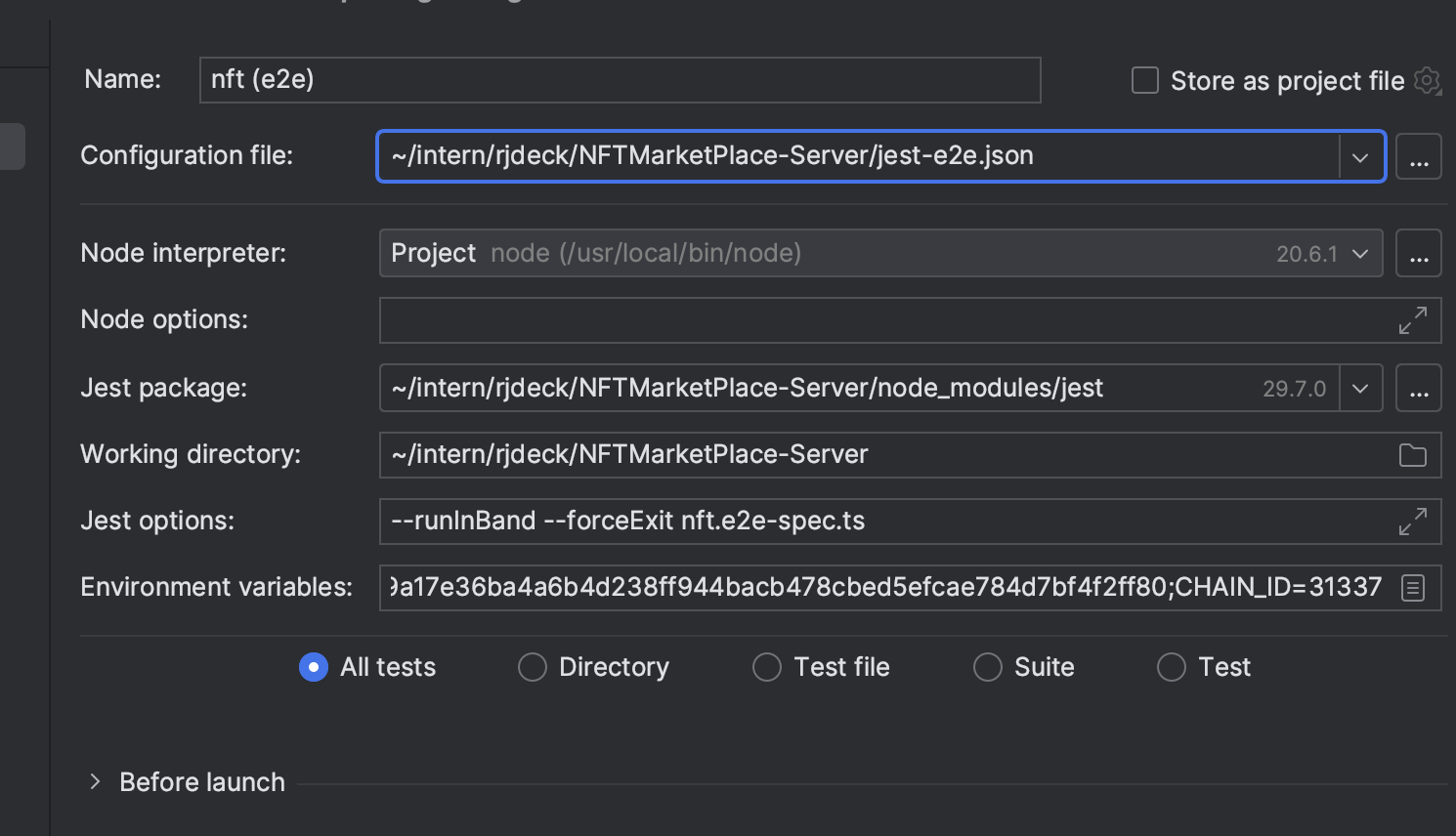e2e nestjs 测试教程
Author: Housu Zhang
规范
- 最外层 describe 的 names 首字母大写,如 'NFT', 'Collection', 其他 describe 都小写。
- 每个内部的 describe 测试一个函数 api。
- it 的描述中,最后加上用 /(方法): 期望返回的 status。
example:
describe("NFT", () => {
describe("my-nfts", () => {
it("It should get a NFT /(GET): 200", async () => {
// 测试用例
});
it("It should return 400 when get a NFT unsuccseefully /(POST): 400", async () => {
// 测试用例
});
});
});
前期准备
- jest 包在我们组织下的 package 中已经存在了,只需要通过 github token 认证你的 github 账号即可使用组织下的 package。
- 配置 github token:在 github 网页中的 setting 处,下载你自己的 token (只需要 package read 权限即可)。然后运行
export GITHUB_TOKEN=your_token进行配置。 - 通过 pnpm 来更新咱们的 node。
pnpm i
- configuration 配置。配置 Configuration file 为项目中的 jest-e2e.json,配置必要的环境变量。

- 对于我们的某些项目,我们测试的时候需要一些镜像,服务要在本地启动。具体情况具体操作。如 NFTMarketPlace-Server 中,我们需要在开启本地链,启动 docker 的情况下测试。
通过
pnpm blockchain:up启动测试链,通过pnpm docker:up启动 docker 镜像。如果缺少本地链,会发生AggregateError。如果没有启动 docker,会出现 `ERROR [RedisModule]
测试钩子(hook)介绍
beforeAll
在 beforeAll 中,我们一般放入启动项目的逻辑,如环境变量的 mock,prisma 初始化,app 启动等等。例如:
beforeAll(async () => {
class MockConfigService {
config: { [key: string]: any } = {
PORT: parseInt(process.env.PORT) || 3340,
HOST: process.env.HOST || "localhost",
// other code
// ...
JWT_SECRET: "test",
};
setConfig({ key, value }: { key: string; value: any }) {
this.config[key] = value;
}
onInit = jest.fn().mockImplementation(() => {});
}
// use in-memory mongodb
mongod = await MongoMemoryReplSet.create({
replSet: { count: 1, storageEngine: "wiredTiger" },
});
process.env.DATABASE_URL = mongod.getUri("test");
// create a mock redis client
const moduleFixture: TestingModule = await Test.createTestingModule({
imports: [AppModule],
})
.overrideProvider(CONFIG_SERVICE_TOKEN)
.useClass(MockConfigService)
.overrideProvider(FirebaseService)
.useValue({
initApp: jest.fn().mockImplementation(() => {}),
})
.compile();
client = moduleFixture.get<Redis>(getRedisToken("default"));
configService =
moduleFixture.get<ConfigService<IAppConfig>>(CONFIG_SERVICE_TOKEN);
configService.setConfig({ key: "JWT_SECRET", value: "test" });
jwtService = moduleFixture.get(JwtService);
// create a nest app and use cookie parser as middleware
app = moduleFixture.createNestApplication();
app.use(cookieParser());
await app.init();
});
beforeEach
beforeEach 意在将的作用是在每个测试案例(test case)开始之前执行一些代码。 这通常用于准备测试环境,确保每个测试都是在相同的条件下开始的。减少重复的代码逻辑。
例如:将每次测试会用到的测试数据写入测试数据库的操作,可以放到 beforeEach 中,减少冗余。
beforeEach(async () => {
const data1 = {
name: "NFTContract1",
description: "Test contract description",
sourceCode: "test",
solidityVersion: "0.8.18+commit.87f61d96",
abi: JSON.stringify([]),
bytecode: JSON.stringify("0x1234"),
};
const data2 = {
name: "NFTContract2",
description: "Test contract description",
sourceCode: "test",
solidityVersion: "0.8.18+commit.87f61d96",
abi: JSON.stringify([]),
bytecode: JSON.stringify("0x1234"),
};
const data3 = {
name: "NFTContract3",
description: "Test contract description",
sourceCode: "test",
solidityVersion: "0.8.18+commit.87f61d96",
abi: JSON.stringify([]),
bytecode: JSON.stringify("0x1234"),
};
await prismaService.nftContract.create({ data: data1 });
await prismaService.nftContract.create({ data: data2 });
await prismaService.nftContract.create({ data: data3 });
});
afterAll
在所有测试案例执行完毕后运行一次。它用于执行清理任务,如断开数据库连接或清理测试后的状态。
例如,关闭各种服务(对应 beforeAll 中开启的服务)
afterAll(async () => {
await app.close();
await mongod.stop();
await prismaService.$disconnect();
});
afterEach
在每个测试案例执行后运行。它通常用于清理测试案例可能创建的任何副作用,例如删除临时文件或关闭数据库连接。
afterEach(async () => {
await prismaService.nftContract.deleteMany({});
await prismaService.nonce.deleteMany({});
});
tips
only 字段
因为我们的测试往往依赖于配置的环境变量,因此 webstorm 提供的运行单独测试的按钮一般是不能成功的。In this scenario, 我们可以通过 only 字段来单独运行某一个 describe 或者 it。
例如:
describe.only("this is a test describe", () => {
// XXX
});
it.only("this is a test it /(GET) 200", () => {
// XXX
});
skip 字段
有些时候,因为一些其他因素(服务挂了),有的测试会挂掉。这个时候我们可以用 skip 字段跳过这些测试,保持好心情。
例如:
describe.skip("this is a test describe", () => {
// XXX
});
it.skip("this is a test it /(GET) 200", () => {
// XXX
});
mock
在 NestJS 项目中使用 Jest 进行测试时,经常需要对依赖项进行模拟(mocking)。这可以帮助我们隔离测试的部分,以确保单元测试只关注当前组件的行为。以下是使用 Jest 进行模拟的常用方法和示例。
Mocking Modules
在 NestJS 中,你可能需要模拟整个模块。Jest 提供了 jest.mock() 函数来实现这一点。
// my.module.ts
jest.mock("./my.module", () => {
return {
MyService: jest.fn().mockImplementation(() => {
return {
myMethod: jest.fn().mockReturnValue("mocked value"),
};
}),
};
});
mocking function
有时候,你只想模拟一个特定的函数,而不是整个类。你可以使用 jest.spyOn() 和 mockImplementation() 或 mockReturnValue() 来实现。
jest.spyOn(myFunctions, "myFunction").mockReturnValue("mocked value");
测试用例
it 和 test
it 是一个函数,用于定义一个测试用例。它是 test 函数的别名,所以 it 和 test 在功能上是等价的,都用于编写单个的测试块。每个 it 或 test 块描述了一个特定的测试场景,并包含了执行该场景所需的测试代码。
这里是 it 函数的基本结构:
it("should do something /(GET): 200", () => {
// 测试代码
});
test("should do something /(POST): 201", () => {
// 测试代码
});
实战例子:
contract e2e 测试
// 各种import
import { Test, TestingModule } from "@nestjs/testing";
// ...
// mock solc
jest.mock(
"../src/contract/solc",
() => ({
Solc: jest.fn().mockImplementation(() => ({
loadRemoteCompiler: jest.fn().mockResolvedValue({
compile: jest.fn().mockReturnValue(
JSON.stringify({
contracts: {
"NFTContract.sol": {
NFTContract: {
evm: {
bytecode: {
object: "0x1234",
},
},
abi: [],
},
},
},
})
),
}),
})),
})
);
describe("Contract", () => {
let app: INestApplication;
let prismaService: PrismaService;
let mongod: MongoMemoryReplSet;
beforeAll(async () => {
// use in-memory mongodb
mongod = await MongoMemoryReplSet.create({
replSet: { count: 1, storageEngine: "wiredTiger" },
});
process.env.DATABASE_URL = await mongod.getUri("test");
class MockConfigService {
config: { [key: string]: any } = {
PORT: parseInt(process.env.PORT) || 3340,
// 超多东西,懒得写
};
onInit = jest.fn().mockImplementation(() => {});
}
const moduleFixture: TestingModule = await Test.createTestingModule({
imports: [AppModule],
})
.overrideProvider(FirebaseService)
.useValue({
initApp: jest.fn().mockImplementation(() => {}),
})
.overrideProvider(CONFIG_SERVICE_TOKEN)
.useClass(MockConfigService)
.compile();
// create a nest
app = moduleFixture.createNestApplication();
await app.init();
prismaService = moduleFixture.get<PrismaService>(PrismaService);
});
describe("create", () => {
// 成功的情况
it("should create a new contract /(POST): 201", async () => {
const data = {
name: "NFTContract",
description: "Test contract description",
sourceCode:
'// SPDX-License-Identifier: GPL-3.0\\npragma solidity ^0.8.0;\\n\\ncontract NFTContract {\\n string public message = \\"Hello, World!\\";\\n}',
solidityVersion: "0.8.18+commit.87f61d96",
};
await request(app.getHttpServer())
.post("/contract/create")
.send(data)
.expect(201)
.expect((res) => {
expect(res.body).toHaveProperty("id");
expect(res.body.name).toBe(data.name);
expect(res.body.description).toBe(data.description);
expect(res.body.sourceCode).toBe(data.sourceCode);
expect(res.body.solidityVersion).toBe(data.solidityVersion);
expect(res.body).toHaveProperty("abi");
expect(res.body).toHaveProperty("bytecode");
});
});
// 不成功的情况
it("should not create contract with wrong name /(POST): 400", async () => {
const data = {
name: "NFTContract1",
description: "Test contract description",
sourceCode:
'// SPDX-License-Identifier: GPL-3.0\\npragma solidity ^0.8.0;\\n\\ncontract NFTContract {\\n string public message = \\"Hello, World!\\";\\n}',
solidityVersion: "0.8.18+commit.87f61d96",
};
await request(app.getHttpServer())
.post("/contract/create")
.send(data)
.expect(400);
});
});
});